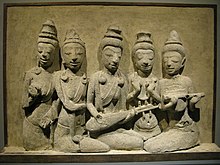Khu Bua

Khu Bua (Thai: คูบัว, pronounced [kʰūː būa̯]) is an archaeological site 12 km southeast of the town Ratchaburi, Thailand. It dates from the 6th century Dvaravati culture and was one of major cities of this kingdom.[1]: 299–300, 302, 307–309
Within the roughly rectangular site of around 800x2000 m surrounded by an earthen wall and a moat 44 archaeological sites were found within and outside the wall, with the foundations of Wat Khlong Suwannakhiri being the largest and best preserved. Excavations were done in 1957, 1960 and 1961. The findings - ceramic figurines, wheels of law and stone tablets - are now at display at the National Museum in Ratchaburi and Bangkok, as well as in the small museum next to Wat Khlong.The architectural and artistic features are those of the Indian Gupta Dynasty, which promoted buddhism in the region after it was first introduced during the reign of Ashoka.Evidence has been found to suggest that Buddhism has flourished in Thailand for over 1,000 years, with more than 60 traces of ancient sites, and most of them are places of worship related to Buddhism, both in Theravada and Mahayana cult. By the objects excavated in the Khu Bua city area A sculpture of stucco and clay Used to decorate buildings such as Buddha images, Bodhisattva, angels or noble people, etc. It is also found. Tools Various accessories that reflect the advanced technological developments of the time And it can be assumed that the city of Khu Bua prospered in the Dvaravati period, around 11-16 Buddhist centuries and most of the artifacts found Currently preserved at the Ratchaburi National Museum.There has been a stucco image of a female musician discovered in Khu Bua archaeological site. Reflect the culture of those days
Wat Khlong was registered as a historical site in 1962.[2]

References[]
- ^ Higham, C., 2014, Early Mainland Southeast Asia, Bangkok: River Books Co., Ltd., ISBN 9786167339443
- ^ ประกาศกรมศิลปากร เรื่อง ขึ้นทะเบียนโบราณสถาน (PDF). Royal Gazette (in Thai). 79 (97 ง): 2279. 1962-10-30.
External links[]
| Wikimedia Commons has media related to Khu Bua Ancient Town. |
Further reading[]
- Saraya, Dhida (1999). (Sri) Dvaravati. Muang Boran Publishing House. ISBN 978-974-7381-34-4.
- "Kaleidoscopic Cross-sections - Western Mountain Ranges, Valleys, and Plains" (PDF). Thailand: Traits and Treasures: 413–414. Archived from the original (PDF) on 2011-07-20. Retrieved 2007-12-20.
- Archaeological sites in Thailand
- Former populated places in Thailand
- Geography of Ratchaburi province
- Buildings and structures in Ratchaburi province
- Dvaravati
- Thai building and structure stubs
